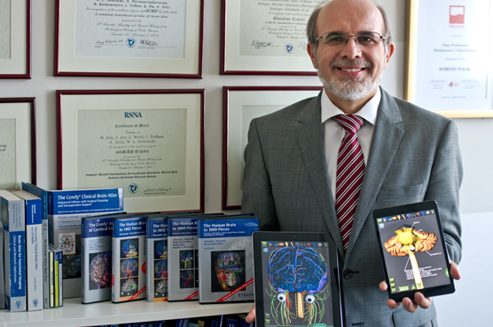Wieslaw Nowinski began his studies in the field of computer design, receiving his Master of Science degree from Warsaw University of Technology in 1977 and completing his PhD studies with distinction at Łódź University of Technology in 1985. He has lived in Singapore since 1991, where he continues his work with Biomedical Imaging Lab, a research centre founded by the Agency for Science, Technology and Research.
Nowinski holds numerous patents and has written over 500 scientific publications, but he is also an active entrepreneur. He started three high-tech companies for in the medical technology sector, with a fourth and fifth in the pipeline. He has even presented his idea to establish a European Academic Incubator Network to support innovation and entrepreneurship in younger generations to both the European Commission and the Polish government.
He received two radiology Oscars awarded by the Radiological Society of North America. In 2013, he was awarded the title of Pioneer in Medicine in the USA. He also received the “Outstanding Pole of 2012” award in the “Teraz Polska” competition.
Invention: 3-D brain atlases for clinical use
Exploring the brain allows us to better understand brain disorders, treat trauma, and train future medical doctors and neuroscientists. Wieslaw Nowinski’s high-resolution, 3D brain atlases have revolutionised the world of brain mapping and have given us unprecedented insights into our most complex organ.
Nowinski’s brain atlases are the result of combining thousands of brain scans into a 3D representation. Extremely large amounts of data are involved: A single brain scan contains about 20 million pixels. To deal with the tremendous complexity, Nowinski converted the scans into 3000 levels; each individual level is additionally compressed so that the atlases can stay affordable and will work even on a tablet.
Marketed under the name Cerefy, the brain atlases are used for research and education, as well as for the diagnosis and treatment of brain disorders such as Parkinson’s, stroke and psychiatric conditions. Considered the most advanced and beautiful brain atlases on the market, Nowinski’s creations have helped treat hundreds of thousands of people so far.
How it works?
Brain atlases, are the product of massive amounts of different kinds of images and data. Neuroinformatics data allow researchers like Wieslaw Nowinski to take a variety of brain scans and combine them to create sophisticated maps. However, Nowinski has gone a step further to generate three-dimensional brain models users can manipulate and navigate in different ways, tailoring different atlases for different purposes: from the exploration of the brain’s vascular system to the diagnosis of diseases such as Alzheimer’s.
Images of specific patients are “superimposed” on one of Nowinski’s atlases and the corresponding tissue structures are compared in the two cerebral hemispheres in order to pinpoint deviations from healthy tissue. In addition, the atlases can also guide neurosurgeons to the specific area in which the electrodes have to be placed for deep brain stimulation.
Because Wieslaw Nowinski didn’t want to expose other people to the time commitment and the health risks associated with intensive MRI scanning, Nowinski stepped in to have his own head scanned – sometimes for several hours at a time. Still, he was not satisfied with the aesthetics of his brain atlases, despite the crisp, high-quality brain scans they contained. He solicited the support of his wife and daughter, who worked to make the interface more engaging and the brain models more visually appealing. “This has made it nice and colourful”, says Nowinski. “It is a real family project”.
Source: European Patent Office
Photo © European Patent Office


